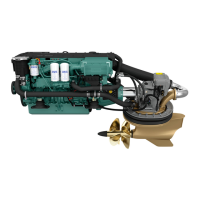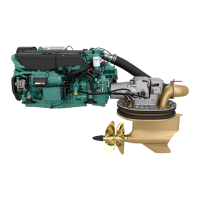Do you have a question about the Volvo Penta IPS 400 and is the answer not in the manual?
Explains how safety information is presented in the manual and on the engine.
Provides a general account of basic safety precautions for boat operation and engine maintenance.
Guidance for new boat owners on learning controls and safe operation.
Highlights that poor maintenance and lack of safety equipment cause accidents at sea.
Recommends a habit of visually checking the engine and compartment before and after operation.
Advises against sudden course changes and emphasizes propeller safety.
Details safety measures during refueling to prevent fire and explosion hazards.
Warns against starting the engine with suspected fuel leaks or in explosive surroundings.
Recommends installing and using a safety breaker accessory for enhanced safety.
Covers risks associated with fuel, lubricants, batteries, and electrical components.
Discusses Volvo Penta's commitment to environmental care and responsible operation.
Details the recommended procedure for running in a new engine for the first 10 operating hours.
Advises on using recommended fuel and oils and adhering to change intervals for engine longevity.
Stresses the importance of using Volvo Penta original parts and authorized dealers for service.
Introduces the Volvo Penta IPS as a new standard in marine propulsion systems.
Details the features contributing to the amazing maneuverability of the Volvo Penta IPS drive-units.
Details how the EVC system controls the steering for smooth and exact operation.
Explains electronic control of speed and gear shifting via dual function controls.
Covers the ability to install and transfer control between multiple helm stations.
Explains the benefits and activation of engine speed synchronization for twin-engine setups.
Describes how instruments connect via a serial communication bus, simplifying wiring.
Details the mandatory tachometer display for EVC systems, showing operational info, messages, and alarms.
Explains the EVC system display as a complement or replacement for instruments, offering more data display.
Lists and briefly describes common instruments like tachometers, voltmeters, and gauges.
Explains the function of the ignition lock and its positions for starting and securing the engine.
Guides on navigating the EVC tachometer display, including startup and menu access.
Outlines the main menu options available on the EVC tachometer, such as Speed, Water Temp, and Trip.
Outlines the structure and operation of the EVC system display, controlled by front panel buttons.
Explains the electronic lever control for shift functions and engine speed adjustment.
Details the procedure to disengage the shift function, allowing the lever to control only engine speed.
Lists essential visual checks and preparations before starting the engine, including fuel and oil levels.
Explains engine pre-heating and how cold starting is managed by the engine control unit.
Guides on reading and interpreting various engine instruments like tachometer, oil pressure, and coolant temperature.
Details the correct procedure for stopping the engine, including warm-up and key usage.
Explains how to use the auxiliary stop function if the normal stopping procedure fails.
Lists important checks to perform after stopping the engine, such as inspecting for leaks.
Provides guidance on engine care when the boat is not in use for extended periods.
Provides general advice on maintaining the engine for reliability and environmental performance.
Outlines the mandatory first service inspection by an authorized Volvo Penta workshop.
Explains Volvo Penta's Extended Protection option for marine diesel engines.
Emphasizes a visual inspection of the engine and room to detect abnormalities and prevent issues.
Refers to Technical Data for correct oil volume specifications for engine lubrication.
Details the procedure for checking and topping up engine oil, emphasizing correct timing and level.
Explains how to check the coolant level and add coolant if necessary, with safety warnings.
Details the procedure for draining the engine's fresh water cooling system.
Covers the process of inspecting and replacing the seawater pump impeller for cooling system function.
Details the procedure for replacing the fuel filter, including safety warnings and bleeding the system.
Explains the function and proper use of the main electrical switch to prevent damage.
Describes the automatic circuit breakers (fuses) for the engine and drive-unit and how to reset them.
Notes that the EVC system is protected by engine circuit breakers and advises investigating overloads.
Provides instructions for checking the drive-unit oil level, emphasizing proper shutdown time and avoiding overfilling.
Details the procedure for changing the drive-unit oil and filter, including refill quantities and gasket replacement.
Details the steps for removing propellers from the drive-unit, including using special tools.
Outlines the steps for inhibiting the engine and transmission to prevent damage during storage.
Provides instructions for jump-starting the engine using auxiliary batteries, with safety warnings.
Lists faults related to engine speed sensor, explaining causes, reactions, and actions.
Covers faults related to fuel pressure, temperature, and water in fuel, with troubleshooting steps.
Details faults related to low seawater pressure, explaining causes and required maintenance checks.
Provides general engine data including model, power, speeds, volumes, and inclination limits.
Explains how safety information is presented in the manual and on the engine.
Provides a general account of basic safety precautions for boat operation and engine maintenance.
Guidance for new boat owners on learning controls and safe operation.
Highlights that poor maintenance and lack of safety equipment cause accidents at sea.
Recommends a habit of visually checking the engine and compartment before and after operation.
Advises against sudden course changes and emphasizes propeller safety.
Details safety measures during refueling to prevent fire and explosion hazards.
Warns against starting the engine with suspected fuel leaks or in explosive surroundings.
Recommends installing and using a safety breaker accessory for enhanced safety.
Covers risks associated with fuel, lubricants, batteries, and electrical components.
Discusses Volvo Penta's commitment to environmental care and responsible operation.
Details the recommended procedure for running in a new engine for the first 10 operating hours.
Advises on using recommended fuel and oils and adhering to change intervals for engine longevity.
Stresses the importance of using Volvo Penta original parts and authorized dealers for service.
Introduces the Volvo Penta IPS as a new standard in marine propulsion systems.
Details the features contributing to the amazing maneuverability of the Volvo Penta IPS drive-units.
Details how the EVC system controls the steering for smooth and exact operation.
Explains electronic control of speed and gear shifting via dual function controls.
Covers the ability to install and transfer control between multiple helm stations.
Explains the benefits and activation of engine speed synchronization for twin-engine setups.
Describes how instruments connect via a serial communication bus, simplifying wiring.
Details the mandatory tachometer display for EVC systems, showing operational info, messages, and alarms.
Explains the EVC system display as a complement or replacement for instruments, offering more data display.
Lists and briefly describes common instruments like tachometers, voltmeters, and gauges.
Explains the function of the ignition lock and its positions for starting and securing the engine.
Guides on navigating the EVC tachometer display, including startup and menu access.
Outlines the main menu options available on the EVC tachometer, such as Speed, Water Temp, and Trip.
Outlines the structure and operation of the EVC system display, controlled by front panel buttons.
Explains the electronic lever control for shift functions and engine speed adjustment.
Details the procedure to disengage the shift function, allowing the lever to control only engine speed.
Lists essential visual checks and preparations before starting the engine, including fuel and oil levels.
Explains engine pre-heating and how cold starting is managed by the engine control unit.
Guides on reading and interpreting various engine instruments like tachometer, oil pressure, and coolant temperature.
Details the correct procedure for stopping the engine, including warm-up and key usage.
Explains how to use the auxiliary stop function if the normal stopping procedure fails.
Lists important checks to perform after stopping the engine, such as inspecting for leaks.
Provides guidance on engine care when the boat is not in use for extended periods.
Provides general advice on maintaining the engine for reliability and environmental performance.
Outlines the mandatory first service inspection by an authorized Volvo Penta workshop.
Explains Volvo Penta's Extended Protection option for marine diesel engines.
Emphasizes a visual inspection of the engine and room to detect abnormalities and prevent issues.
Refers to Technical Data for correct oil volume specifications for engine lubrication.
Details the procedure for checking and topping up engine oil, emphasizing correct timing and level.
Explains how to check the coolant level and add coolant if necessary, with safety warnings.
Details the procedure for draining the engine's fresh water cooling system.
Covers the process of inspecting and replacing the seawater pump impeller for cooling system function.
Details the procedure for replacing the fuel filter, including safety warnings and bleeding the system.
Explains the function and proper use of the main electrical switch to prevent damage.
Describes the automatic circuit breakers (fuses) for the engine and drive-unit and how to reset them.
Notes that the EVC system is protected by engine circuit breakers and advises investigating overloads.
Provides instructions for checking the drive-unit oil level, emphasizing proper shutdown time and avoiding overfilling.
Details the procedure for changing the drive-unit oil and filter, including refill quantities and gasket replacement.
Details the steps for removing propellers from the drive-unit, including using special tools.
Outlines the steps for inhibiting the engine and transmission to prevent damage during storage.
Provides instructions for jump-starting the engine using auxiliary batteries, with safety warnings.
Lists faults related to engine speed sensor, explaining causes, reactions, and actions.
Covers faults related to fuel pressure, temperature, and water in fuel, with troubleshooting steps.
Details faults related to low seawater pressure, explaining causes and required maintenance checks.
Provides general engine data including model, power, speeds, volumes, and inclination limits.
| Brand | Volvo Penta |
|---|---|
| Model | IPS 400 |
| Category | Engine |
| Language | English |











